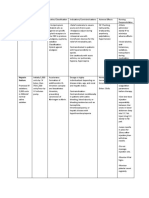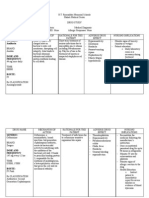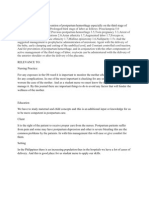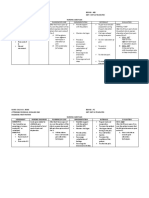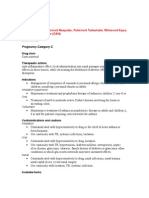Pregnancy Traditions (Mountain Province)
Pregnancy Traditions (Mountain Province)
Uploaded by
HELLE AUBSCopyright:
Available Formats
Pregnancy Traditions (Mountain Province)
Pregnancy Traditions (Mountain Province)
Uploaded by
HELLE AUBSOriginal Title
Copyright
Available Formats
Share this document
Did you find this document useful?
Is this content inappropriate?
Copyright:
Available Formats
Pregnancy Traditions (Mountain Province)
Pregnancy Traditions (Mountain Province)
Uploaded by
HELLE AUBSCopyright:
Available Formats
PREGNANCY TRADITIONS (MOUNTAIN PROVINCE)
Pregnant women are expected to continue their daily work except carrying heavy load and doing heavy work, while
being careful not to lose her baby. This physically active life is observed to make labor easy.
Pregnant woman is allowed to eat anything except twin bananas because she might have twins. There are some other
taboo foods depending on what is available in the locality.
When somebody sees a pregnant woman carrying a heavy load, he or she is supposed to carry it for her.
If the pregnant woman is touched by the sun’s rays at sunrise while she takes a bath, her child may become an
albino.
Adults, especially the elders of the community, instruct the pregnant woman not to go to places that are “nangilin”
(like far away water bodies or forests as something bad might happen to the baby) for the luta (environmental spirits)
or anito may become envious of the infant and cause either a miscarriage or deformity. Hot or cold springs are taboo,
for these are dwellings of spirits.
She should not go to wakes (these are unhappy occasions and people then knew that the emotional state of the
mother affects the unborn).
pregnant woman must never sleep near open windows or openings of the house to avoid a kind of bird that is
believed to prey on the hearts of the unborn and newborn babies.
People are also not supposed to make a pregnant woman cry or angry.
During celebrations like weddings, she is given a double portion.
LABOR TRADITIONS (MOUNTAIN PROVINCE)
The husband is expected to be around so wherever he is working, he is supposed to be home when the expected date
is near and wait for the birth of the child. This ensures that the woman has somebody to help her 24/7, anytime she
delivers or has a problem. The mother of the pregnant woman or her mom-in-law is expected also to be there
especially during the expected birth of the first child. These ensure hands-on tutorial lessons thus there is passage of
necessary knowledge, attitudes and skills regarding birthing and life, in general, throughout generations.
The women of previous generations normally delivered their baby themselves, with minimal assistance from their
husbands, who merely heated the water to bathe the newborn and a sharpened bamboo is also prepared for the
cutting of umbilical cord of the baby. But to those who has someone with them, the mang- ilot or an old woman that
have some experiences for childbirths hastens the birth by a gently downward drawing of the hands about the
woman’s abdomen. The pregnant woman who is about to give birth is in standing position (omalagey), while
grasping some things like chair or some sturdy things for her to hold on or she may take a more animal-like position
or kneeling position (idokmog), placing both hands and feet on the ground.
If the labor was abnormally long, the insup-ok (female/male shaman or manbunong) was called in to invoke the
anito’s aid. Evil spirits in the house who might be causing the difficulty were driven away by the smoke of burning
rags and rice husk. In cases of difficult childbirth, the inchawat (midwife) was called in.
References:
The Bontok People of the Philippines: History, Culture, Customs and Tradition [Philippine Indigenous People |
Ethnic Group] Bontoc, Mountain Province, (2022). Yodisphere. Retrieved on September 30, 2022
from https://www.yodisphere.com/2022/07/Bontok-Tribe-Culture-Bontoc-People.html
Guidangen, J. S. (2020). Child Birth Rites of Kankanaey in Northern Luzon. International Journal of English
Literature and Social Sciences. September 30, 2020 from https://ijels.com/upload_document/issue_
files/34IJELS-101202154-ChildBirth.pdf
You might also like
- Helping Your Breech Baby Turn 1Document28 pagesHelping Your Breech Baby Turn 1Suiro Teas100% (4)
- BFCDocument8 pagesBFCIrene GunongNo ratings yet
- Guide in Making The FCA 1Document18 pagesGuide in Making The FCA 1Zedrake CaraanNo ratings yet
- Rosenbaum FrankfordDocument334 pagesRosenbaum FrankfordJorge Luis Rivera AgostoNo ratings yet
- Evolution of CHN Worldwide and in The PhilippinesDocument17 pagesEvolution of CHN Worldwide and in The PhilippinesBethrice MelegritoNo ratings yet
- Discharge PlanDocument1 pageDischarge PlanJullie Anne SantoyoNo ratings yet
- Total Abdominal Hysterectomy Bilateral Salpingo Oophorectomy (Tahbso) Nursing Responsibilities Rationale Pre-OperativeDocument4 pagesTotal Abdominal Hysterectomy Bilateral Salpingo Oophorectomy (Tahbso) Nursing Responsibilities Rationale Pre-OperativeMiar QuestNo ratings yet
- CHN-PPT (2) 3-2Document35 pagesCHN-PPT (2) 3-2Lina Michelle Matheson BrualNo ratings yet
- Drug StudyDocument2 pagesDrug Studypopoyoio100% (2)
- DRUG STUDY - AmoebiasisDocument7 pagesDRUG STUDY - AmoebiasisErika NicaNo ratings yet
- Ceftriaxone Sodium Drug StudyDocument1 pageCeftriaxone Sodium Drug StudyMelissa Marie CustodioNo ratings yet
- Learning Derived (Lysha)Document1 pageLearning Derived (Lysha)Choy DavidNo ratings yet
- CefuroximeDocument2 pagesCefuroximeReem NurNo ratings yet
- Non-Modifiable Factor Modifiable Factor: South-East Asia, Eastern, Mediterranean, Western Pacific, and The AmericasDocument2 pagesNon-Modifiable Factor Modifiable Factor: South-East Asia, Eastern, Mediterranean, Western Pacific, and The Americaschristian quiaoitNo ratings yet
- Common Side Effects of Oxytocin Include:: CNS: Maternal: COMADocument3 pagesCommon Side Effects of Oxytocin Include:: CNS: Maternal: COMAann camposNo ratings yet
- Filipino Culture, Values, and Practices in Relation To Difficult Childbearing and ChildrearingDocument8 pagesFilipino Culture, Values, and Practices in Relation To Difficult Childbearing and ChildrearingRheeanne AmilasanNo ratings yet
- Ncma 219 PrelimsDocument59 pagesNcma 219 Prelimssharlainegarcia1103No ratings yet
- Finasteride: A Drug Study Presented To The Faculty of The Nursing DepartmentDocument7 pagesFinasteride: A Drug Study Presented To The Faculty of The Nursing DepartmentBaron SheeNo ratings yet
- 14 Drug StudyDocument15 pages14 Drug StudyTricia AlvarezNo ratings yet
- Health Care Ethics PRELIM ReviewerDocument11 pagesHealth Care Ethics PRELIM ReviewerVeejay CervantesNo ratings yet
- Jacildo LT Module 6 TCNDocument2 pagesJacildo LT Module 6 TCNMeryville JacildoNo ratings yet
- Papillary Thyroid Ca: Group. 1 B Grand CaseDocument16 pagesPapillary Thyroid Ca: Group. 1 B Grand CaseAdora Dela CruzNo ratings yet
- Drug Study (Ketorolac)Document3 pagesDrug Study (Ketorolac)Andrea De RuedaNo ratings yet
- JM Drug Study CaseDocument4 pagesJM Drug Study CaseMilky Lescano LargozaNo ratings yet
- Drug Study NurseryDocument2 pagesDrug Study Nurseryjulesubayubay54280% (1)
- Health Teaching Plan ContentDocument2 pagesHealth Teaching Plan ContentEdmr Slzar100% (1)
- Drug Study HepatitisDocument7 pagesDrug Study HepatitisKateLayaogNo ratings yet
- 4 Cefazolin Drug StudyDocument4 pages4 Cefazolin Drug Studyshadow gonzalezNo ratings yet
- AzithromycinDocument1 pageAzithromycincoleenlimkinNo ratings yet
- Name Mucosta Tablets 100 Description PDFDocument7 pagesName Mucosta Tablets 100 Description PDFnanda RaharjaNo ratings yet
- Primaxin (Imipenem - Cilistatin)Document2 pagesPrimaxin (Imipenem - Cilistatin)ENo ratings yet
- PrimaquineDocument3 pagesPrimaquineVijayakumar NsNo ratings yet
- High-Risk Pregnancy Premature Rupture of Membranes (PROM)Document3 pagesHigh-Risk Pregnancy Premature Rupture of Membranes (PROM)elimcangcoNo ratings yet
- Case (Acute Gastroenteritis) Group 4Document36 pagesCase (Acute Gastroenteritis) Group 4EljhayrosNo ratings yet
- Discharge Planning DengueDocument2 pagesDischarge Planning DengueChyNo ratings yet
- Drug StudyDocument2 pagesDrug Studymegreen GamingNo ratings yet
- Module 2Document11 pagesModule 2mirai desuNo ratings yet
- Nursing Diagnosis Care Plan IDADocument1 pageNursing Diagnosis Care Plan IDAAbdallah AlasalNo ratings yet
- GitDocument302 pagesGitjgcriste100% (7)
- Drug Name Mechanism of Action Administration Indications Contraindications Adverse Reactions Nursing ResponsibilitiesDocument1 pageDrug Name Mechanism of Action Administration Indications Contraindications Adverse Reactions Nursing ResponsibilitiesIvan Liquiran AvenadoNo ratings yet
- Pediatric Community Acquired Pneumonia - Moderate Risk: University of The Cordilleras College of NursingDocument22 pagesPediatric Community Acquired Pneumonia - Moderate Risk: University of The Cordilleras College of NursingJemimah AdaclogNo ratings yet
- Impaired Skin IntegDocument2 pagesImpaired Skin IntegMarcus Philip GonzalesNo ratings yet
- Cefoxitin, Metronidazole, RanitidineDocument2 pagesCefoxitin, Metronidazole, RanitidineDaryl PaglinawanNo ratings yet
- FNCPDocument6 pagesFNCPlovlyNo ratings yet
- Ob WardDocument2 pagesOb WardIsah AlmogelaNo ratings yet
- Case Study SSSSDocument37 pagesCase Study SSSSsplakener100% (1)
- Ethico Legal Considerations and Issues in The Care of Sick Mother and Child QuestionsDocument5 pagesEthico Legal Considerations and Issues in The Care of Sick Mother and Child QuestionsQueeny Anne ApilNo ratings yet
- In Summary of Discharge TeachingDocument2 pagesIn Summary of Discharge Teachingdalaginding clophNo ratings yet
- Peros: General AssessmentDocument4 pagesPeros: General AssessmentKaycee TolingNo ratings yet
- (Brand Name) & Date Ordered General Class and Family Specific IndicationDocument2 pages(Brand Name) & Date Ordered General Class and Family Specific IndicationNicole Grace VillegasNo ratings yet
- Generic Name Brand Name Drug Class Action Indication Contra-Indication S/E Nsg. Consideratio NSDocument1 pageGeneric Name Brand Name Drug Class Action Indication Contra-Indication S/E Nsg. Consideratio NSKenny CastroNo ratings yet
- Name: Oyardo Cherilyn BED NO.: 408 Attending Physician: DR - Baldovino Diet: Diet As Tolerated Diagnosis: Post-PartumDocument7 pagesName: Oyardo Cherilyn BED NO.: 408 Attending Physician: DR - Baldovino Diet: Diet As Tolerated Diagnosis: Post-PartumshinloNo ratings yet
- Drug Study and NCP For Eamc Ob-Gyne Ward Case PresDocument4 pagesDrug Study and NCP For Eamc Ob-Gyne Ward Case PresvirnzrobzNo ratings yet
- Basic Ethical Principles Stewards 1. StewardshipDocument7 pagesBasic Ethical Principles Stewards 1. StewardshipElla EllaNo ratings yet
- Reaction Paper About The Film, The Good NurseDocument1 pageReaction Paper About The Film, The Good Nursepaulbadajos55No ratings yet
- Family Nursing Care PlanDocument3 pagesFamily Nursing Care PlanCelissa Mauriz HilarioNo ratings yet
- Unit 1: Introduction To Community Health Nursing Chapter 1: Fundamental Concepts of Community Health NursingDocument140 pagesUnit 1: Introduction To Community Health Nursing Chapter 1: Fundamental Concepts of Community Health NursingChevelle Valenciano-GaanNo ratings yet
- BudesonideDocument4 pagesBudesonideapi-3797941No ratings yet
- NCP 2 LRDR For PrintDocument2 pagesNCP 2 LRDR For PrintGeorge PandaNo ratings yet
- Pedia Drug Study NaproxenparacetamolDocument3 pagesPedia Drug Study NaproxenparacetamolKuro HanabusaNo ratings yet
- Ventricular Septal Defect, A Simple Guide To The Condition, Treatment And Related ConditionsFrom EverandVentricular Septal Defect, A Simple Guide To The Condition, Treatment And Related ConditionsNo ratings yet
- The Ride of Your Life: What I Learned about God, Love, and Adventure by Teaching My Son to Ride a BikeFrom EverandThe Ride of Your Life: What I Learned about God, Love, and Adventure by Teaching My Son to Ride a BikeRating: 4.5 out of 5 stars4.5/5 (2)
- Elearning Ncm107 MidtermDocument9 pagesElearning Ncm107 MidtermHELLE AUBSNo ratings yet
- Elearning Prelim NCM107 2Document7 pagesElearning Prelim NCM107 2HELLE AUBSNo ratings yet
- FNCP Family Nursing Care Plan 1 Poor Environmental Sanitation Health ThreatDocument8 pagesFNCP Family Nursing Care Plan 1 Poor Environmental Sanitation Health ThreatHELLE AUBSNo ratings yet
- Household Survey Form 2Document6 pagesHousehold Survey Form 2HELLE AUBSNo ratings yet
- ElearningDocument3 pagesElearningHELLE AUBSNo ratings yet
- Biak Na Bato and MalolosDocument1 pageBiak Na Bato and MalolosHELLE AUBSNo ratings yet
- Patients ResponsibilitiesDocument3 pagesPatients ResponsibilitiesHELLE AUBSNo ratings yet
- Household Survey Form 2Document6 pagesHousehold Survey Form 2HELLE AUBSNo ratings yet
- Def. of HistoryDocument3 pagesDef. of HistoryHELLE AUBSNo ratings yet
- Section 7Document1 pageSection 7HELLE AUBSNo ratings yet
- The Perceived Effects of Physical Punishment To TeenagersDocument23 pagesThe Perceived Effects of Physical Punishment To TeenagersClare VenturaNo ratings yet
- Strategy Intervention To Prevent and Reduce Postpartum Depression: A Systematic ReviewDocument6 pagesStrategy Intervention To Prevent and Reduce Postpartum Depression: A Systematic Reviewevania nitaNo ratings yet
- Westmead Childbirth and Parenting Courses - FactsheetDocument5 pagesWestmead Childbirth and Parenting Courses - FactsheetsunilNo ratings yet
- Cer 217 Infertility Final Report PDFDocument418 pagesCer 217 Infertility Final Report PDFSara Al-FerkhNo ratings yet
- Session 6:: Administration of Early Childhood CenterDocument6 pagesSession 6:: Administration of Early Childhood CenterZiziNo ratings yet
- Prevalence of Anaemia in Pregnant Women Attending AntenatalDocument19 pagesPrevalence of Anaemia in Pregnant Women Attending Antenatalchebetnaomi945No ratings yet
- Clarisse E-PEC 101 Module 2Document3 pagesClarisse E-PEC 101 Module 2Kyji EstradaNo ratings yet
- Parental Alienation and "Reunification" Camps - Berkman Bottger Newman - Schein LLPDocument2 pagesParental Alienation and "Reunification" Camps - Berkman Bottger Newman - Schein LLPFamily Court-CorruptionNo ratings yet
- Case and Guide QuestionsDocument5 pagesCase and Guide QuestionsKenneth NovenoNo ratings yet
- Guiding Principles For Promoting Adolescent HealthDocument5 pagesGuiding Principles For Promoting Adolescent Healthhenandiar syahariniNo ratings yet
- 101 Ideas For Family EvangelismDocument7 pages101 Ideas For Family Evangelismian barrigaNo ratings yet
- YasminaDocument11 pagesYasminaAndre KeichianNo ratings yet
- Chapter 20 Outine A History of Western Society AP EuroDocument5 pagesChapter 20 Outine A History of Western Society AP Eurodrea4152100% (2)
- My Kid Refuses To Do HomeworkDocument8 pagesMy Kid Refuses To Do Homeworkafnoescijgwdgw100% (1)
- Doing Homework On TimeDocument8 pagesDoing Homework On Timedfmktlzod100% (1)
- MAA Directed By: Sarjun KMDocument27 pagesMAA Directed By: Sarjun KMJan ArthanNo ratings yet
- Impact of Mobile Media On ChildrenDocument3 pagesImpact of Mobile Media On ChildrenHussain AbbasNo ratings yet
- Come What MayDocument139 pagesCome What Mayboubou.robbiNo ratings yet
- Teenage Mother Research PaperDocument5 pagesTeenage Mother Research Papergw0ttn7j100% (1)
- Juvenile BS CRIM3Document187 pagesJuvenile BS CRIM3marvin lorenzoNo ratings yet
- Cuestionarios Inglés ASQ SE 2Document122 pagesCuestionarios Inglés ASQ SE 2María Auxiliadora VasconezNo ratings yet
- Review Article 2Document13 pagesReview Article 2ShreeNo ratings yet
- Assignment 2Document76 pagesAssignment 2A Noor Ahmad100% (1)
- Kin 355-Final Newsletter Turn inDocument5 pagesKin 355-Final Newsletter Turn inapi-272746935No ratings yet
- High Risk Approach in Maternal and Child HealthDocument6 pagesHigh Risk Approach in Maternal and Child Healthjyotshna sahoo100% (5)
- Reviewer in Succession - FINALSDocument60 pagesReviewer in Succession - FINALSma. vidiaNo ratings yet
- Growth & Development: Mary Lourdes Nacel G. Celeste, RN, MD Ellen H. Tinio, RN, MDDocument132 pagesGrowth & Development: Mary Lourdes Nacel G. Celeste, RN, MD Ellen H. Tinio, RN, MDNacel CelesteNo ratings yet
- Retelling The Stories of Our LivesDocument35 pagesRetelling The Stories of Our Livessun angelaNo ratings yet








